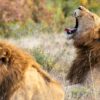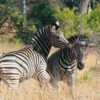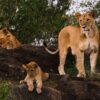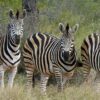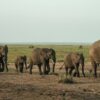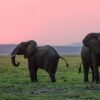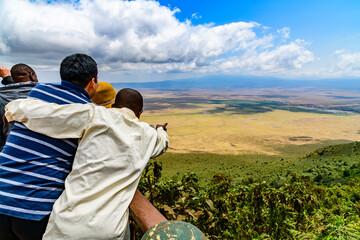10 Reasons to Visit the Ngorongoro Crater
Discover 10 reasons to visit the Ngorongoro Crater! See the Big 5, meet the Maasai, and explore a stunning volcanic caldera. Plan your safari today.
Imagine standing on the edge of an ancient, collapsed volcano, looking down into a vast, lush world teeming with wildlife. This isn’t a scene from a movie; it’s the Ngorongoro Crater in Tanzania. About two and a half million years ago, a volcano that might have been taller than Mount Kilimanjaro erupted and collapsed, creating the world’s largest intact and unfilled volcanic caldera. Today, it’s a self-contained ecosystem, a natural enclosure for some of Africa’s most famous animals.
If you’re wondering if this should be on your list of places to visit in Africa, the answer is a resounding yes. Whether Tanzania is your first country to visit in Africa or you’re a seasoned safari-goer, the Ngorongoro Crater offers an experience you won’t find anywhere else. Let’s dive into why this incredible destination should be next on your travel list.
1. Witness “Africa’s Garden of Eden” in the Ngorongoro Crater
They call the Ngorongoro Crater “Africa’s Garden of Eden” for a good reason. The crater floor is a bustling metropolis of over 25,000 large animals.
What does that mean for you?
It means unparalleled wildlife viewing. The natural enclosure of the crater walls creates a unique environment where animals thrive. From thousands of wildebeest and zebras to elephants and lurking predators, the crater floor is a non-stop theater of the wild.
A Self-Contained World
Because of the enclosed nature of the caldera, many animals live their entire lives within its walls. This creates an incredibly dense and stable wildlife population. You get to see a snapshot of a complete ecosystem, with predator and prey interactions playing out right before your eyes. The fertile volcanic soil supports rich grasslands, which in turn supports a huge number of herbivores.
Pro Tip: Bring a good pair of binoculars. While you’ll get close to the action, binoculars will help you spot that snoozing leopard in a distant tree or the details of a rare bird.
2. See the Big Five in a Single Day in the Ngorongoro Crater
For many safari enthusiasts, seeing the “Big Five” (lion, leopard, rhinoceros, elephant, and Cape buffalo) is the ultimate goal. In the Ngorongoro Crater, it’s not just a possibility; it’s a probability.
Here’s the deal.
The crater’s compact environment makes it one of the best places on the continent to see all five of these magnificent creatures in a single game drive.
The Best Place for Black Rhinos
The critically endangered black rhino is notoriously hard to spot. However, the Ngorongoro Crater is a sanctuary for them. Thanks to dedicated conservation efforts, a small but stable population of black rhinos thrives here. Seeing one of these prehistoric-looking animals grazing on the crater floor is a truly special moment and often the final tick on a visitor’s Big Five checklist.
Pro Tip: Head out for your game drive early in the morning. The animals are most active during the cooler parts of the day, and you’ll have a better chance of seeing predators on the move.
3. Experience a UNESCO World Heritage Site
The Ngorongoro Crater isn’t just another beautiful spot; it’s a place of global significance. Designated a UNESCO World Heritage Site in 1979, its importance is recognized worldwide.
What Makes the Ngorongoro Crater a World Heritage Site?
The crater is recognized for its stunning natural beauty, incredible biodiversity, and its archaeological importance. The Ngorongoro Conservation Area, which includes the crater, is a rare place where humans and wildlife coexist. The Ngorongoro Crater history is not just geological; it’s also human. The nearby Olduvai Gorge is where some of the earliest hominid fossils were found, earning it the title “The Cradle of Humankind.”
Pro Tip: Take a moment to appreciate the sheer scale from the viewpoint on the crater rim. The Ngorongoro Crater altitude at the rim is about 2,286 meters (7,500 feet), offering breathtaking views of the entire caldera. Don’t forget your camera for some epic Ngorongoro crater photos.
4. Meet the Maasai People
A visit to the Ngorongoro Conservation Area offers a unique cultural dimension. This isn’t just a wildlife park; it’s a living landscape.
What role do the Maasai people play in the Ngorongoro conservation area?
The Maasai have been living a semi-nomadic, pastoralist lifestyle in this region for hundreds of years. Unlike in many national parks, here they are allowed to live and herd their cattle alongside the wildlife. This creates a remarkable scene where red-robed Maasai herders guide their livestock across plains dotted with zebras and wildebeest. Visiting a Maasai village gives you a respectful and authentic insight into their traditions, dances, and daily life.
Pro Tip: When visiting a Maasai village, be open and respectful. Ask questions, participate in the welcome dance, and consider purchasing some of their beautiful handmade jewelry. It’s a great way to support the local community directly.
5. Explore the Greater Crater Highlands in the Ngorongoro Crater
While the main crater gets all the attention, the surrounding Crater Highlands offer their own adventures. This is a land of rolling hills, smaller craters, and lush forests.
You won’t believe what’s out there.
Beyond the main caldera, you can find places like Olmoti and Empakaai Craters. These offer fantastic hiking opportunities away from the crowds.
Olmoti and Empakaai Craters
A guided hike to the Olmoti Crater takes you through beautiful forested paths to a shallow, grassy caldera. The Empakaai Crater holds a deep soda lake that is often fringed with thousands of pink flamingos. Hiking down to its shore is an unforgettable experience, offering a sense of tranquility and remoteness. These excursions showcase that there’s more to the area than just the main attraction.
Pro Tip: If you’re interested in hiking, plan for an extra day. Accommodations like The Highlands Ngorongoro are perfectly positioned to explore these lesser-known gems. Check out The Highlands Tanzania photos to see what awaits.
6. Enjoy Incredible Bird Watching in the Ngorongoro Crater
Even if you’re not a dedicated “birder,” you’ll be impressed by the avian life in the Ngorongoro Crater. With over 500 species recorded, it’s a paradise for bird watching.
From Ostriches to Flamingos
On the crater floor, you can spot everything from the world’s largest bird, the ostrich, to the kori bustard, the world’s heaviest flying bird. The soda lakes, like Lake Magadi, attract thousands of flamingos, creating a stunning pink spectacle against the blue water. Secretary birds, grey crowned cranes, and numerous raptors are also common sights.
Pro Tip: The rainy season (November to April) is the best time for birding, as migratory birds from Europe and Asia arrive, adding to the resident populations.
7. Find Your Perfect Stay
Your accommodation is a huge part of your safari experience, and the Ngorongoro area offers some of the best. Whether you’re looking for ultimate luxury or a classic tented camp, you’ll find it here.
Luxury Lodges and Tented Camps
Many lodges are perched right on the crater rim, offering jaw-dropping views from your room. The Ngorongoro Serena Safari Lodge, built into the rim, is a prime example. For a more exclusive experience, consider a Ngorongoro Crater Safari Lodge like the andBeyond Ngorongoro Crater Lodge or one of the excellent Ngorongoro Crater Camps. These options provide a perfect base for your luxury safari Tanzania.
Pro Tip: Staying on the crater rim allows you to be one of the first vehicles to descend in the morning, maximizing your game viewing time before the crowds build up.
8. It’s a Photographer’s Dream
Get your cameras ready. The combination of stunning landscapes, incredible light, and dense wildlife makes the Ngorongoro Crater a photographer’s paradise. The Ngorongoro crater location and unique topography create a backdrop you won’t find anywhere else.
Golden Hour in the Caldera
The light during sunrise and sunset is simply magical. As the sun rises, it casts a golden glow across the landscape, illuminating the morning mist. In the evening, the setting sun paints the crater walls in warm hues. The sheer Ngorongoro Crater size—about 260 square kilometers (100 square miles)—provides endless photographic compositions.
Pro Tip: A zoom lens is your best friend for wildlife photography, but don’t forget a wide-angle lens to capture the immense scale of the crater.
9. Combine it with Other Top Safari Spots
The Ngorongoro Crater is a key player in Tanzania’s famous “Northern Circuit.” Its location makes it incredibly easy to combine with other world-class safari destinations.
Your Perfect Tanzania Safari Itinerary
You can easily create a comprehensive Tanzania safari itinerary that includes the Ngorongoro Crater. Start in Tarangire National Park, famous for its elephants and baobab trees, then head to Ngorongoro, and finish in the legendary Serengeti National Park to witness the Great Migration. Many Tanzania safari packages are designed around this classic route.
Pro Tip: A road transfer between the parks is like an extended game drive. You’ll travel through the scenic Great Rift Valley, passing villages and spotting wildlife along the way.
10. The Calving Season Spectacle
If you time your visit right, you can witness one of nature’s greatest shows. From December to March, the Great Wildebeest Migration moves into the southern Serengeti and the Ngorongoro Conservation Area for the calving season.
A Time of New Life and High Drama
During this period, hundreds of thousands of wildebeest calves are born within a few weeks. This explosion of new life attracts predators in huge numbers, leading to dramatic and thrilling wildlife encounters. It’s an excellent time to see cheetahs, lions, and hyenas in action.
Pro Tip: This period is considered part of the green season. The landscape is lush and beautiful, and there are often fewer tourists than in the peak dry season. It’s a fantastic time for a safari.
Frequently Asked Questions
What is so special about the Ngorongoro Crater?
Its combination of a massive, intact volcanic caldera, incredibly dense wildlife population, and the unique coexistence of Maasai communities and animals makes it truly one-of-a-kind. It’s a self-contained world offering some of the most reliable Big Five sightings in Africa.
Is the Ngorongoro Crater worth visiting?
Absolutely. The dramatic scenery, exceptional wildlife viewing, and cultural richness make it a highlight of any trip to Africa. It consistently ranks as a favorite destination for both first-time visitors and safari veterans.
Can you see the Big 5 in Ngorongoro crate?
Yes, the Ngorongoro Crater is one of the most reliable places in Africa to see the Big Five (lion, leopard, rhino, elephant, and buffalo) in a single day. The black rhino population, in particular, is a major draw.
Can animals escape the Ngorongoro Crater?
While the steep crater walls act as a natural barrier, they are not insurmountable. Some animals, like elephants and buffalo, do migrate in and out, but many species choose to stay year-round due to the abundance of food and water.
What does Ngorongoro mean in English?
The name “Ngorongoro” is an onomatopoeic word from the Maasai language. It was named for the sound of the cowbell (“ngoro ngoro”) that their cattle wear.
Is Ngorongoro a wonder of the world?
Yes, the Ngorongoro Crater was voted as one of the Seven Natural Wonders of Africa in 2015. Its geological significance and biodiversity are globally recognized.
How much does it cost to go to Ngorongoro crater safari?
The Ngorongoro Crater safari cost can vary widely. Factors include the level of accommodation, length of stay, and whether it’s part of a larger package. The Ngorongoro safari entrance fee is a fixed daily rate, but the overall Ngorongoro safari price or Tanzania safari price will depend on your choices.
What is the experience of Ngorongoro Crater safari?
The experience is a six-hour game drive on the crater floor, descending steep roads from the rim. You’ll explore diverse habitats like grasslands, forests, and lakes, witnessing an incredible concentration of wildlife in a setting unlike any other safari destination.
What is the best time to visit Ngorongoro Crater?
The best time to visit Ngorongoro Crater for wildlife viewing is during the dry season from June to October. However, the calving season from December to March offers a unique spectacle. The Tanzania safari best time often depends on what you want to see. For more discussions, you can even check a Tanzania safari Reddit thread.
Ready for an unforgettable adventure?
Your Tanzania Safari is just a click away!
Let the experts at Thrill Bound Adventures handle all the details for your safari booking so you can focus on making memories. From thrilling game drives to custom-tailored Kenyan expeditions, we bring your dream trip to life.
Contact Thrill Bound Adventures today to book your next adventure!
Contact
- Mobile: +254 713 915 070
- Hotline: +254 713 915 070
- thrillboundadventuresltd@gmail.com
- info@thrillboundadventures.com

